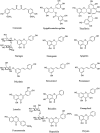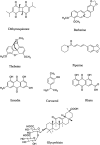Targeting Neurological Manifestations of Coronaviruses by Candidate Phytochemicals: A Mechanistic Approach
- PMID: 33708124
- PMCID: PMC7941749
- DOI: 10.3389/fphar.2020.621099
Targeting Neurological Manifestations of Coronaviruses by Candidate Phytochemicals: A Mechanistic Approach
Abstract
The novel coronavirus 2019 (COVID-19) caused by severe acute respiratory syndrome coronavirus 2 (SARS-CoV-2) has made a wide range of manifestations. In this regard, growing evidence is focusing on COVID-19 neurological associations; however, there is a lack of established pathophysiological mechanisms and related treatments. Accordingly, a comprehensive review was conducted, using electronic databases, including PubMed, Scopus, Web of Science, and Cochrane, along with the author's expertize in COVID-19 associated neuronal signaling pathways. Besides, potential phytochemicals have been provided against neurological signs of COVID-19. Considering a high homology among SARS-CoV, Middle East Respiratory Syndrome and SARS-CoV-2, revealing their precise pathophysiological mechanisms seems to pave the road for the treatment of COVID-19 neural manifestations. There is a complex pathophysiological mechanism behind central manifestations of COVID-19, including pain, hypo/anosmia, delirium, impaired consciousness, pyramidal signs, and ischemic stroke. Among those dysregulated neuronal mechanisms, neuroinflammation, angiotensin-converting enzyme 2 (ACE2)/spike proteins, RNA-dependent RNA polymerase and protease are of special attention. So, employing multi-target therapeutic agents with considerable safety and efficacy seems to show a bright future in fighting COVID-19 neurological manifestations. Nowadays, natural secondary metabolites are highlighted as potential multi-target phytochemicals in combating several complications of COVID-19. In this review, central pathophysiological mechanisms and therapeutic targets of SARS-CoV-2 has been provided. Besides, in terms of pharmacological mechanisms, phytochemicals have been introduced as potential multi-target agents in combating COVID-19 central nervous system complications.
Keywords: COVID-19; SARS-CoV-2; coronaviruses; nervous system; neurology; pharmacology; phytochemicals; signaling pathways.
Copyright © 2021 Fakhri, Piri, Majnooni, Farzaei and Echeverría.
Conflict of interest statement
The authors declare that the research was conducted in the absence of any commercial or financial relationships that could be construed as a potential conflict of interest.
Figures



Similar articles
-
Mechanistic Aspects of Medicinal Plants and Secondary Metabolites against Severe Acute Respiratory Syndrome Coronavirus 2 (SARS-CoV-2).Curr Pharm Des. 2021;27(38):3996-4007. doi: 10.2174/1381612827666210705160130. Curr Pharm Des. 2021. PMID: 34225607 Review.
-
Phytochemicals: Potential Therapeutic Interventions Against Coronavirus-Associated Lung Injury.Front Pharmacol. 2020 Nov 18;11:588467. doi: 10.3389/fphar.2020.588467. eCollection 2020. Front Pharmacol. 2020. PMID: 33658931 Free PMC article.
-
Brain Renin-Angiotensin System: From Physiology to Pathology in Neuronal Complications Induced by SARS-CoV-2.Anal Cell Pathol (Amst). 2023 Aug 4;2023:8883492. doi: 10.1155/2023/8883492. eCollection 2023. Anal Cell Pathol (Amst). 2023. PMID: 37575318 Free PMC article. Review.
-
An Update on Promising Agents against COVID-19: Secondary Metabolites and Mechanistic Aspects.Curr Pharm Des. 2022;28(29):2415-2425. doi: 10.2174/1381612828666220722124826. Curr Pharm Des. 2022. PMID: 35899955
-
Coronavirus Infection-Associated Cell Death Signaling and Potential Therapeutic Targets.Molecules. 2021 Dec 9;26(24):7459. doi: 10.3390/molecules26247459. Molecules. 2021. PMID: 34946543 Free PMC article. Review.
Cited by
-
Targeting Multiple Signal Transduction Pathways of SARS-CoV-2: Approaches to COVID-19 Therapeutic Candidates.Molecules. 2021 May 14;26(10):2917. doi: 10.3390/molecules26102917. Molecules. 2021. PMID: 34068970 Free PMC article. Review.
-
Modulating Neurological Complications of Emerging Infectious Diseases: Mechanistic Approaches to Candidate Phytochemicals.Front Pharmacol. 2021 Oct 26;12:742146. doi: 10.3389/fphar.2021.742146. eCollection 2021. Front Pharmacol. 2021. PMID: 34764869 Free PMC article. Review.
-
Supercritical Antisolvent Technique for the Production of Breathable Naringin Powder.Pharmaceutics. 2022 Aug 3;14(8):1623. doi: 10.3390/pharmaceutics14081623. Pharmaceutics. 2022. PMID: 36015250 Free PMC article.
-
An insight into the inhibitory mechanism of phytochemicals and FDA-approved drugs on the ACE2-Spike complex of SARS-CoV-2 using computational methods.Chem Zvesti. 2021;75(9):4625-4648. doi: 10.1007/s11696-021-01680-1. Epub 2021 May 8. Chem Zvesti. 2021. PMID: 33994655 Free PMC article.
-
Targeting Mitochondria by Plant Secondary Metabolites: A Promising Strategy in Combating Parkinson's Disease.Int J Mol Sci. 2021 Nov 22;22(22):12570. doi: 10.3390/ijms222212570. Int J Mol Sci. 2021. PMID: 34830453 Free PMC article. Review.
References
-
- Adem Ş., Eyupoglu V., Sarfraz I., Rasul A., Zahoor A. F., Ali M., et al. (2020b). Caffeic acid derivatives (CAFDs) as inhibitors of SARS-CoV-2: CAFDs-based functional foods as a potential alternative approach to combat COVID-19. Phytomedicine 33, 153310. 10.1016/j.phymed.2020.153310 - DOI - PMC - PubMed
Publication types
LinkOut - more resources
Full Text Sources
Other Literature Sources
Miscellaneous

